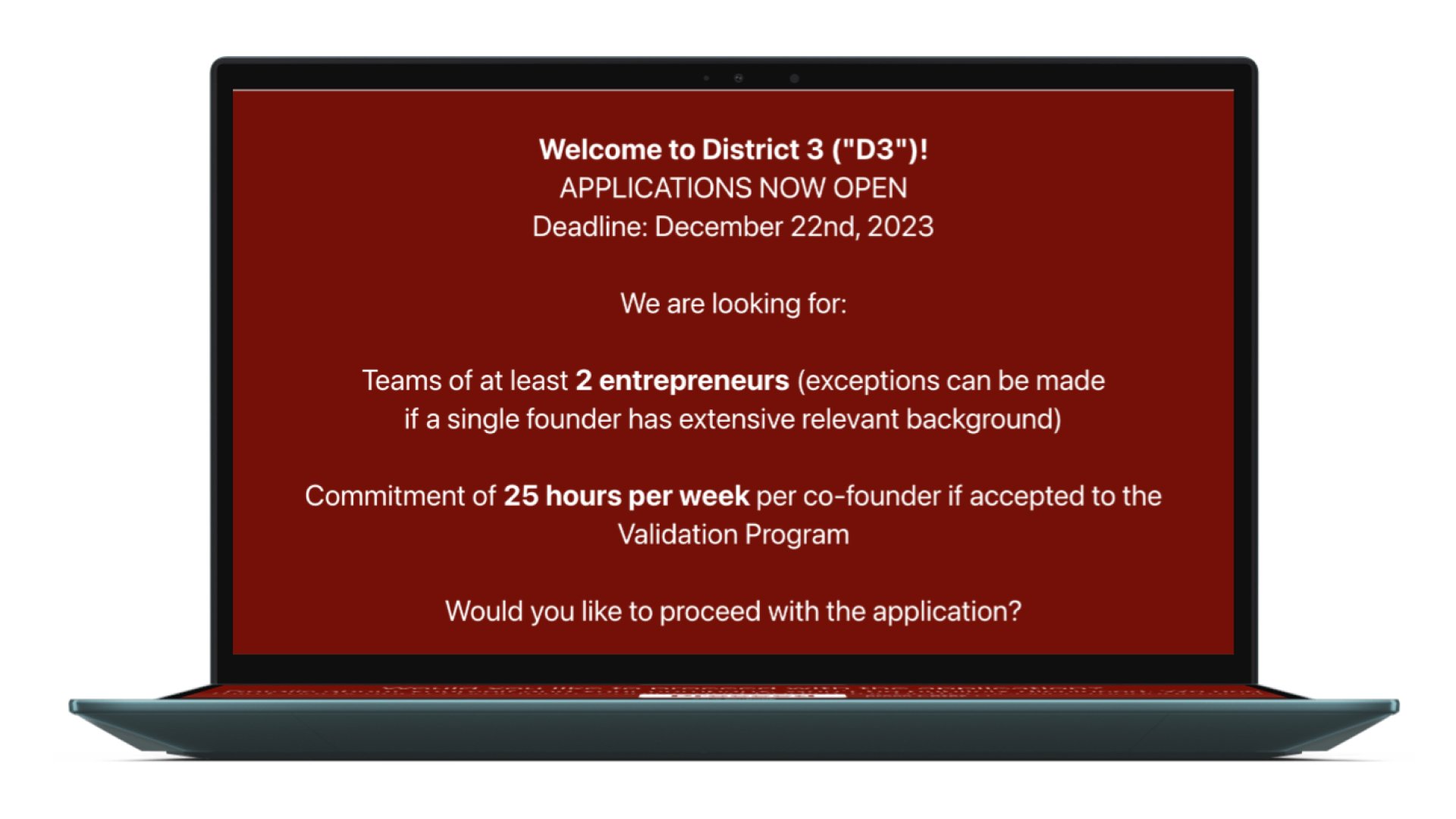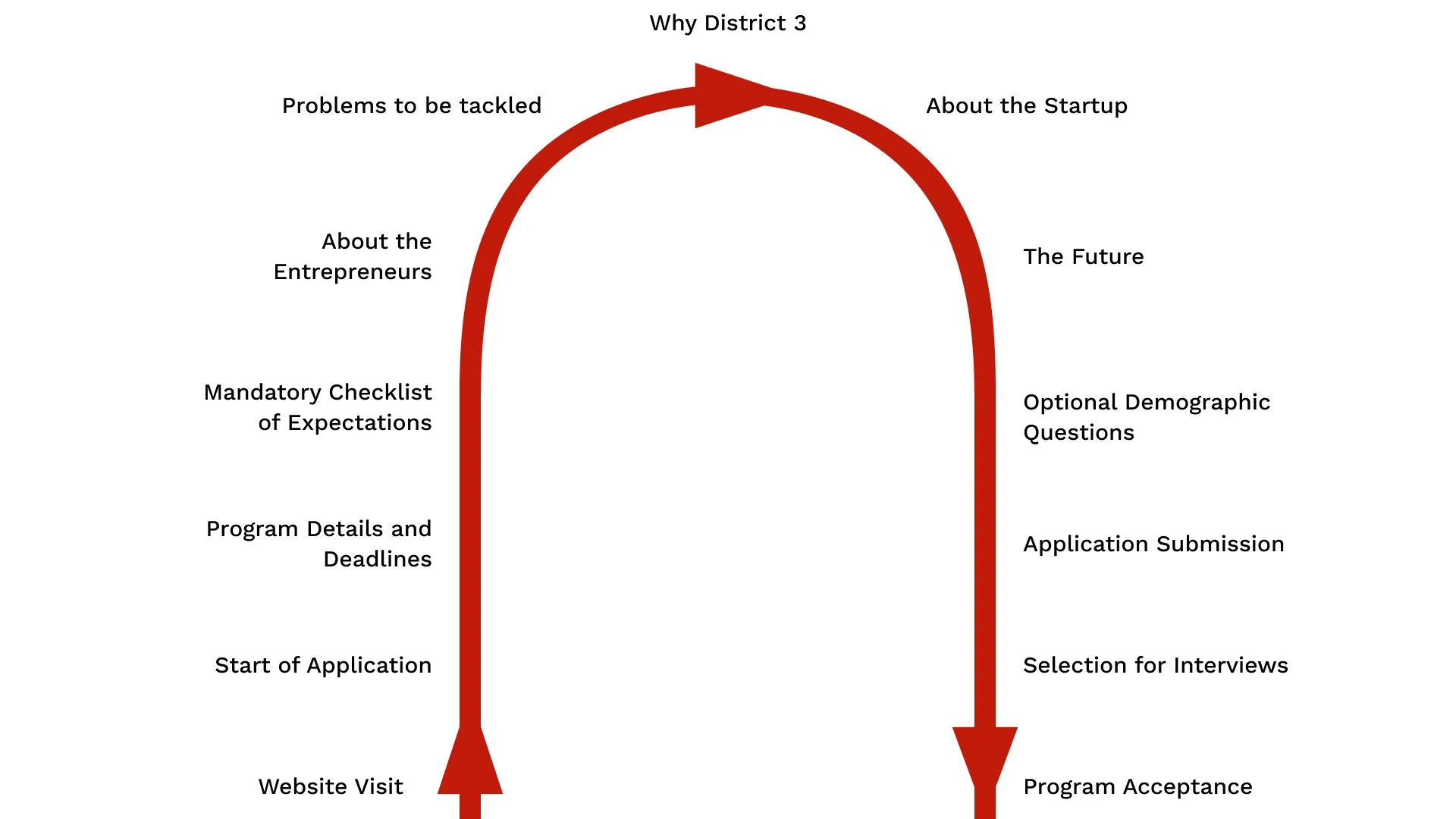
District 3: Boosting quality applications for a high-tech incubator
I was hired by a startup incubator that cultivates startups within the healthcare, bio, and high technology backgrounds. They were looking to accept higher-quality applications to help them be investor-ready.
Client: District 3 Innovation Hub
Role - Contract Product Designer
Team Structure - 2 Marketing Managers, 1 Engineer
Project Type - Application Process Audit and Redesign
Timeline - September - December 2023
Duration - 4 months
Type of Design Services Offered - UX designing for an updated / new application experience
Overview
I was hired to redesign the online application process to attract higher-quality applications
- Goal is to increase high-quality applications that meet District 3’s accelerator criteria, rather than boosting overall volume. Despite receiving 292 applications last year, District 3’s website drew 40,000 visitors, highlighting a stark gap between interest and action.
- I scoped the project with a user-centered product development process and led the redesign of the application.
- I refined applicant targeting, improved the application process, and grew high-quality applications by 10-15% by August 2024.
UX Design
Emphasized progress bar, save and return features within Typeform for user’s ease of usability and allowing time/space for high-quality responses.
Real-time validation and redirection based on applicants’ responses by setting up structural logic flows to enhance the quality of applicants captured
Mandatory long-form responses for core questions to ensure high-quality applications.
Added mobile-friendly design for Typeform to capture edge cases where applicants/founders post validation/ideation stage are looking for a quick and easy application ready to launch and grow
Content Strategy
Rewritten instructions and sample answers to clarify team questions.
Pre-application checklist to reduce drop-off rates and improve completion rates.
Post-application user satisfaction survey for ongoing improvement
Research
My research identified that applicants failed to remain committed throughout the program cycle
Problem Identified: Many applicants fail to stay committed throughout the program cycle.
Findings
- Key Pain Points:
- Rigorous application process and time commitment.
- A mismatch between startup values and incubator expertise.
- Lack of exit strategies and competing priorities for founders.
- Program Challenges: District 3's Head of Marketing noted applicants are often overwhelmed by the workload,
impacting engagement throughout the program.
- Risk Mitigation Strategies:
- Strict selection criteria ensure founders commit to critical program components.
- Cultural alignment between incubators and startups is essential, especially in Canada’s risk-averse
environment.
- Partnerships as a Success Factor:
- Collaboration with industry, academia, and government enhances startup appeal and fosters economic
growth.
- District 3 leverages government grants and academic partnerships to maintain selective recruiting
standards.
Redefining The Goal
How might we attract high-quality startup applications into a high-tech incubator program and retain them through better selection criteria?
Content Strategy #1
I pitched an accountability checklist, navigating users through different program options
Set up an Accountability Checklist to ensure transparency emphasizes the program’s intensity and robustness:
- Ensure applicants understand the 25-hour weekly commitment, including:
- 10+ Qualified Interviews: Validate their startup idea.
- Mentorship Hours: Intensive guidance from experts.
- Market Validation: Identify whether their problem has a real market need.
- Application Clarity: Add a cohort schedule (e.g., application windows, and start dates) to help startups prepare and gauge readiness for the program.
Content Strategy #2
I also pitched industry filters and referral section refinement for better program alignment
- Set up different flows to redirect startups in various industries:
- District 3’s incubator only considers startups in the tech, healthcare, and bio sectors.
- Redirect startups relevant to District 3’s sister program that focuses on social impact, Balsam, to the
dedicated form and filter out others that don’t fit either.
- Tailored paths retain leads while ensuring program alignment.
- Referrals & Leads:
- Refine questions to capture specific referrals (e.g., "Who referred you?").
- This leads to a better indication of where the startup is since many are way past the ideation validation
stage and ready to launch and grow if the startups connect with District 3 via a conference or networking
event.
- More effective data collection and relevant program alignment.
Prototypes
Putting the new application process together
After iterating on the application questions, the incubator mentors and startup interviewers went through them and gave some feedback. We agreed on the following approach for the prototype.
Evaluation Criteria:
Ensure the form captures essential data early on for pre-evaluation while leaving enough room for more in-depth questions during the interview phase.
Collect essential data early:
Startup’s solution, challenges, and proposed plan.
Granularity in team demographics (e.g., track and origin).
Expand the word limit (currently capped at 500 words) for describing solutions/values.
Data Insights:
Track university affiliations to understand Quebec academic-to-entrepreneur conversions.
Opt-in question for updates/promotions from District 3 to streamline communication preferences at the end of the form.
Usability Testings
The first iteration didn’t test well: Checklist Expectations and Poor Application Flow
Usability Test Overview
Participants: 5 working professionals (20s).
Methodology: 30-minute moderated sessions to gather feedback.
Key Findings:
Two Main Issues that lead users to skim the checklist and miss key details:
Lack of clarity in instructions/checklist.
The application questionnaire flow didn’t align well with recruiting high-quality applicants.
Actions Taken:
- Simplify and split requirements into smaller sections and separate pages
- Highlight the timeline and program expectations before users begin the application
- Redirected users to sister programs and revised the questionnaire flow
- Clarify to users that the form auto-saves in case of accidental closure and whether users can edit after submission.
Unexpected Insights from Users:
- Personal details (e.g., gender, age, citizenship) felt intrusive; explain why these are required.
- Applicants wanted the option to upload images.
- Industry options for startups felt too generic—needed more granularity.
- Preference for resumes over LinkedIn profiles.
The Final Solution
The second iteration tested much better!
After the usability tests and interviews, the final set of changes was made as follows:
Clarify why identity data (e.g., gender, citizenship) is mandatory for grant compliance.
Simplify the application for a single co-founder to fill out.
Generalize seasonal program start dates in terms of quarters/seasons to account for the unpredictable nature of District 3’s schedule
Ask for more in-depth information regarding Co-Founder’s roles and relationships with each other (e.g., how long they’ve worked together).
Use a looping structure within Typeform to add up to four additional co-founders.
The Conclusion
I left District3 with a roadmap for the future
What I Observed at the beginning of the project: The original application process was confusing for users, leading to incomplete submissions and misalignment with District 3’s goals. Many users also dropped off during the application process, as it lacked clarity and failed to highlight the benefits of joining District 3.
What I Did:
- Simplified the form structure by breaking down complex requirements into intuitive sections.
- Used conditional logic to guide applicants based on their unique responses.
- Prioritized key details—like timelines and program expectations—earlier in the process to ensure clarity.
- Shifted the tone to emphasize District 3’s value as a high-tech incubator.
- Highlighted tangible outcomes like access to mentorship, funding, and partnerships, creating excitement and trust among applicants.
Possible Next Steps:
- Link Metrics: Automate data collection to track outcomes like the success rates of startups reaching investor-ready and growth stages.
- Plan for Scale and Long-Term Impact: Establish a structure that supports the expansion of programs like Balsam and other new initiatives.
- Personalize the Journey: Incorporate dynamic content based on applicant responses to provide tailored guidance.







